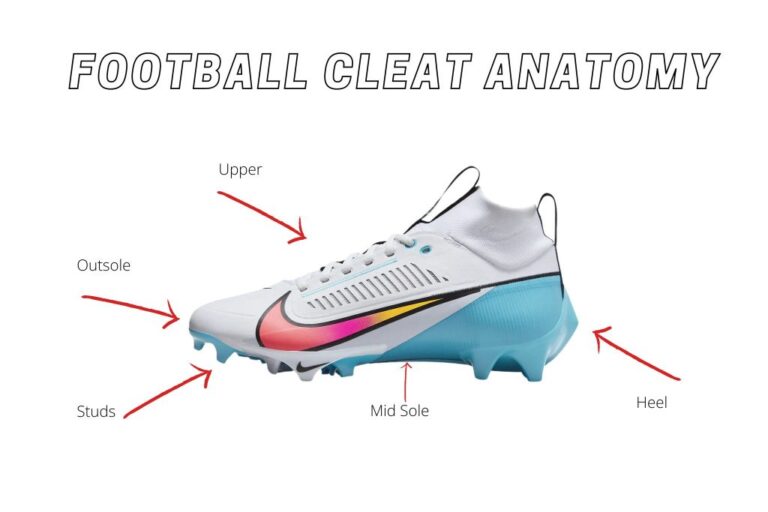Are football and lacrosse cleats the same? This question has intrigued athletes and sports enthusiasts alike for years. While both sports require specialized footwear to optimize performance, the subtle differences in playing surface, movements, and player positions can impact the design of cleats. In this blog, we aim to unravel the mystery surrounding football and lacrosse cleats. By delving into the specific features and technologies of each type of cleat, we will explore whether football and lacrosse cleats are truly interchangeable or if there are distinct advantages to using sport-specific footwear. Join us on this journey as we compare and contrast the nuances of these essential pieces of equipment in the world of sports.
Overview of Football Cleats
Football cleats are specialized footwear designed to enhance performance and safety on the football field. These cleats provide players with the necessary traction, support, and stability to make quick cuts, accelerate, and decelerate effectively during gameplay.
Types of Football Cleats
Football cleats come in various types, including molded, detachable, and turf cleats. Molded cleats have studs permanently attached to the outsole, providing excellent traction on different playing surfaces. Detachable cleats feature studs that can be changed based on field conditions.
Key Features
Modern football cleats incorporate advanced technologies such as lightweight materials, responsive cushioning, and innovative traction patterns to optimize performance. These features help reduce the risk of injuries and enhance agility on the field.
- Lightweight Construction: Ensures agility and speed
- Cushioning: Provides comfort and impact protection
- Traction: Enhances grip and stability

Overview of Lacrosse Cleats
Lacrosse cleats are specially designed athletic footwear tailored for lacrosse players to provide optimal performance on the field. In 2022, these cleats have seen significant advancements in technology and materials to meet the demands of the modern game.
Key Features
- Enhanced Traction: Lacrosse cleats feature aggressive outsoles with cleats or studs strategically placed to offer superior grip on grass or turf surfaces.
- Support and Stability: These cleats are built to provide ankle support and stability to prevent injuries during sudden movements and direction changes.
- Comfort and Durability: Modern lacrosse cleats incorporate cushioning for comfort and durable materials that can withstand the rigors of the game.
Materials and Construction
The construction of lacrosse cleats involves a blend of synthetic materials and leather to ensure a balance between lightweight design and durability. The uppers are often breathable to keep the player’s feet cool and dry throughout the game.
Customization Options
Lacrosse cleats come in various designs, colors, and styles, allowing players to choose footwear that matches their preferences and team colors. Some brands also offer customizable options for a personalized touch.
Key Differences Between Football and Lacrosse Cleats
When it comes to sports like football and lacrosse, having the right footwear is crucial for performance and safety. While football and lacrosse cleats may seem similar at first glance, there are significant differences between the two.
Soles
One of the main differences between football and lacrosse cleats is the design of the soles. Football cleats typically have a larger surface area with more prominent studs to provide traction on grass or turf surfaces. On the other hand, lacrosse cleats feature smaller, more conical studs that are strategically placed to offer quick movements and stability on a variety of surfaces.
Materials
Football cleats are often made from heavier materials like leather to withstand the physicality of the game. In contrast, lacrosse cleats are lighter and more flexible, usually constructed from synthetic materials that allow for agility and speed on the field.
Ankle Support
Football cleats generally provide more ankle support compared to lacrosse cleats due to the nature of the game. Football players require stability and protection for lateral movements and tackles, so football cleats often have higher collars and added padding around the ankle area.

Importance of Choosing the Right Cleats for Each Sport
Choosing the appropriate cleats for a specific sport is crucial for performance, comfort, and preventing injuries. Football and lacrosse cleats may appear similar at first glance, but they are designed differently to suit the unique demands of each sport.
Differences in Cleat Design
Football cleats typically have a larger stud pattern to provide traction on grass and turf surfaces, enabling quick directional changes and stability during running plays. On the other hand, lacrosse cleats have a more versatile stud configuration to support the quick movements, lateral cuts, and sudden sprints required in lacrosse.
Impact on Performance
Wearing the wrong type of cleats can significantly impact an athlete’s performance. Football players may struggle to make quick cuts and changes in direction if they wear lacrosse cleats, leading to reduced agility and speed on the field. Similarly, lacrosse players wearing football cleats may find it hard to maneuver effectively and may risk slipping or getting stuck during crucial plays.
Factors to Consider When Selecting Cleats
When it comes to selecting cleats for football or lacrosse, there are several important factors to consider to ensure optimal performance on the field.
Playing Surface
The type of playing surface is crucial in determining the right cleats for your sport. Football cleats are designed for grass fields, while lacrosse cleats may need to be more versatile to accommodate various field types.
Comfort and Fit
Comfort and fit are essential for any athlete. Make sure the cleats you choose provide adequate cushioning, support, and a snug fit to prevent injuries and enhance performance.
Style of Play
Consider your style of play when selecting cleats. Football players who need speed and agility may opt for lightweight cleats, while lacrosse players requiring stability and traction might choose cleats with a higher ankle cuff.
Durability
Both football and lacrosse involve rigorous movements that can wear out cleats quickly. Look for durable materials and construction to ensure longevity, especially if you play frequently.
Brand and Price
While brand reputation and pricing shouldn’t be the sole basis for your decision, they can indicate quality and performance. Research different brands and models within your budget to find the best cleats for your needs.
Performance Comparison between Football and Lacrosse Cleats
When comparing the performance of football and lacrosse cleats, several key differences become evident. In the realm of sports footwear, these distinctions play a crucial role in enhancing player performance and safety. Let’s delve into the nuanced variations between the two types of cleats to understand their impact on the field.
Design and Traction
Football cleats typically feature a larger stud configuration compared to lacrosse cleats. This design is tailored to provide stability and grip on the grassy football field, allowing players to make quick directional changes and accelerations. On the other hand, lacrosse cleats have a more evenly distributed stud pattern to accommodate the multi-directional movements prevalent in lacrosse gameplay.
Material and Durability
Football cleats are often constructed using durable materials like leather or synthetic blends to withstand the physical demands of football, which involves frequent tackles and intense running. Lacrosse cleats, while also durable, prioritize lightweight materials that offer agility and speed on the lacrosse field where swift footwork is essential.
It is crucial to choose the appropriate cleats based on the sport’s specific requirements to optimize player performance and prevent injuries. Both football and lacrosse cleats undergo continuous improvements to align with the evolving needs of athletes in their respective sports.
Expert Opinions on Cleat Selection
Choosing the right cleats for football and lacrosse is essential for performance and safety on the field. While these sports share similarities, the cleat requirements may differ based on the playing surface and player position.
Factors to Consider
When selecting cleats, experts suggest considering factors such as traction, comfort, durability, and position-specific needs. Football cleats are designed with more ankle support and traction for quick lateral movements, while lacrosse cleats focus on agility and speed.
Expert Recommendations
According to leading sports equipment specialists, it’s crucial to try on different cleats to find the perfect fit. Some recommend opting for detachable studs for versatility on various playing surfaces, ensuring optimal performance in different conditions.
Tips for Maintaining and Extending the Lifespan of Your Cleats
Proper care and maintenance of your cleats can significantly extend their lifespan, ensuring optimal performance and comfort. Here are some essential tips to help you keep your football and lacrosse cleats in top condition:
1. Clean Your Cleats Regularly
After each game or practice session, make sure to clean your cleats thoroughly to remove dirt, mud, and grass stains. Use a brush, mild soap, and water to gently scrub away any debris that can damage the material.
2. Allow Them to Air Dry
After cleaning, air dry your cleats naturally by removing the insoles and stuffing them with newspaper to absorb moisture. Avoid exposing them to direct heat sources like sunlight or a dryer, as this can cause the materials to warp or crack.
3. Store Them Properly
When not in use, store your cleats in a cool, dry place away from direct sunlight or extreme temperatures. Keeping them in a well-ventilated area can prevent mold and mildew growth, preserving the integrity of the shoes.
4. Rotate Your Cleats
Consider rotating between multiple pairs of cleats if you play frequently to allow each pair to dry and recover between uses. This practice can help prevent premature wear and tear on a single pair, extending their overall lifespan.
Frequently Asked Questions
-
- Are football cleats and lacrosse cleats the same?
- While football and lacrosse cleats may appear similar, there are some key differences that set them apart.
-
- What are the main differences between football and lacrosse cleats?
- Football cleats are designed to provide stability and traction for quick movements on grass or turf, whereas lacrosse cleats prioritize agility and speed on a variety of surfaces.
-
- Can I use football cleats for lacrosse, and vice versa?
- It is not recommended to interchange football and lacrosse cleats as they are optimized for the specific demands of each sport.
-
- Do football cleats offer better ankle support compared to lacrosse cleats?
- Football cleats typically have higher collars for increased ankle support, which may vary from the lower cut designs of lacrosse cleats.
-
- Are there any features that are common to both football and lacrosse cleats?
- Both football and lacrosse cleats often feature studs or spikes on the outsole to provide traction and prevent slipping during gameplay.
Final Thoughts: Decoding the Cleat Conundrum
After delving into the intricacies of football and lacrosse cleats, it is evident that these two types of footwear are not the same. While they share some similarities like the use of studs for traction, subtle differences in design and functionality cater to the specific needs of each sport.
Football cleats prioritize stability and ankle support, crucial for quick directional changes and powerful movements on the field. On the other hand, lacrosse cleats focus on agility, speed, and quick acceleration to enhance the player’s performance during the game.
Understanding these distinctions is paramount for athletes to optimize their gameplay and prevent potential injuries. So, the next time you’re gearing up for a match, remember the importance of choosing the right cleats tailored to your sport!





